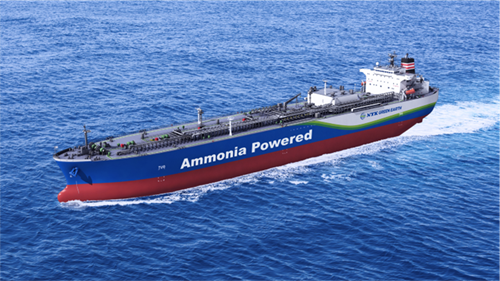NYK’s ammonia-powered gas carrier to hit the water in late 2026
By Julian Atchison on February 14, 2024
Japan Marine United to deliver vessel from Ariake shipyard

Click to learn more. The 40,000 m³ ammonia-powered gas carrier will be constructed in Ariake, Japan, hitting the water in late 2026. Source: NYK.
An NYK-led consortium has been developing an ammonia-fueled medium gas carrier (AFMGC) design since 2021, thanks to funds awarded as part of NEDO’s Green Innovation Fund. ClassNK awarded the design AiP in September 2022. The consortium, which includes Japan Engine Corporation, IHI Power Systems and Nihon Shipyard, has announced that a construction contract has been signed with Japan Marine United to build the 40,000 m³ vessel in Ariake.
The consortium intends this project – one of the first ammonia fuel vessels to hit the water – to contribute to the development of IMO regulations for ammonia fuel:
International rules for ships using ammonia as fuel are not yet in place, and the International Maritime Organization (IMO) is currently discussing the issue. This Project is one of the first to develop ammonia-fueled ships, and the knowledge gained from the construction and operation of AFMGCs will be essential to the progress of discussions at the IMO. The Consortium aims to work closely with ClassNK and Japan’s Ministry of Land, Infrastructure, Transport and Tourism (MLIT) to contribute actively to international rulemaking.
From NYK’s official press release, 25 Jan 2024
The vessel’s main engine will be an ammonia fuel dual-fuel, two-stroke engine built domestically by Japan Engine Corporation. An auxiliary four-stroke engine will also feature on the vessel: this will be an ammonia dual-fuel design developed by IHI Power Systems, who announced successful ammonia combustion tests had taken place in May 2023. This four-stroke design will also feature aboard the A-Tug vessel in Yokohama harbor (indeed, NYK just announced the engine has just been delivered to the shipyard).
The announcement also details co-firing rates anticipated in the vessel engines. Using heavy fuel oil as a pilot fuel, a combustion rate of up to 95% is targeted for the vessel’s main engine, and 80% or more in the auxiliary engine. Overall, this will achieve an emissions reduction rate of at least 80% for the vessel.